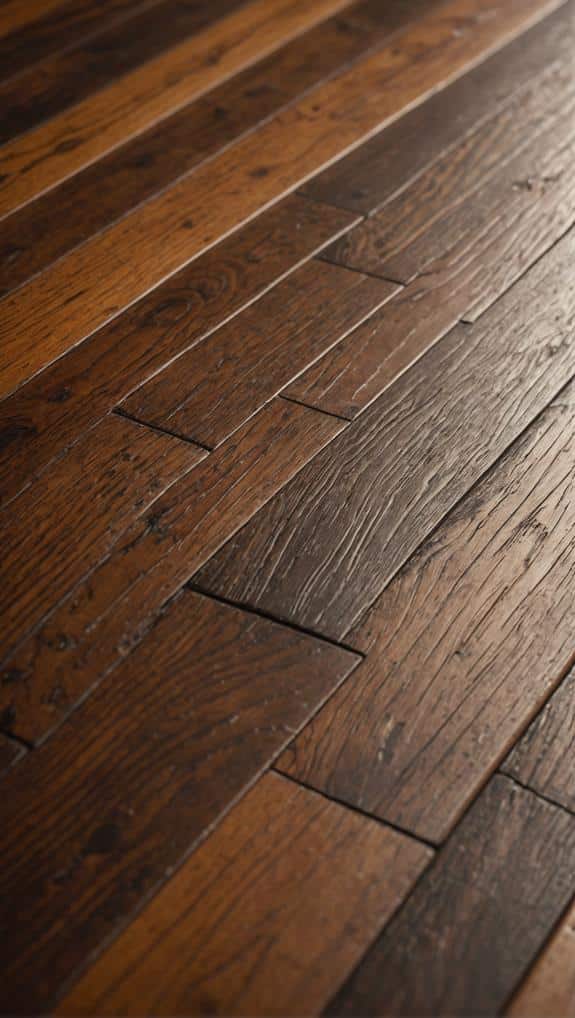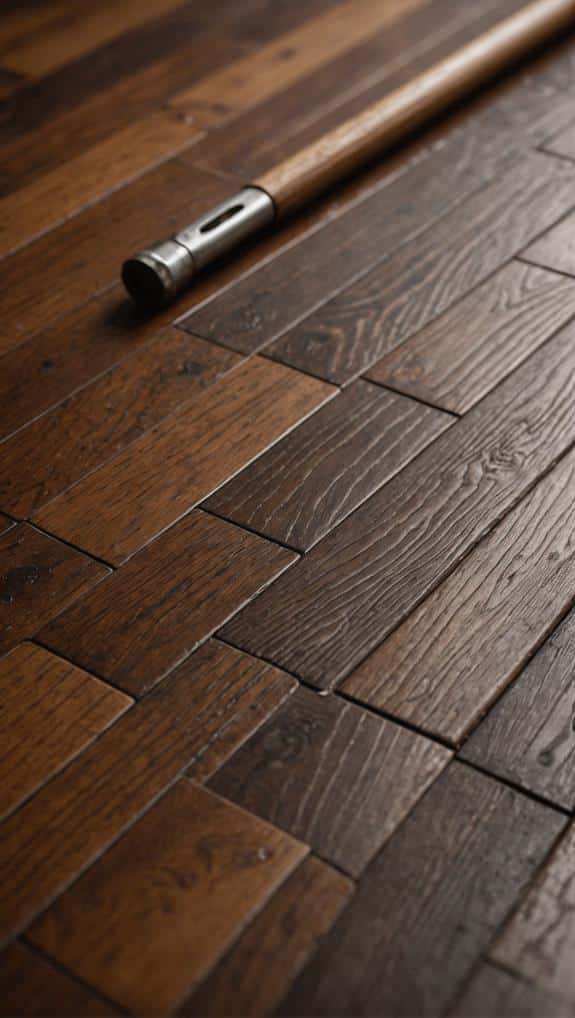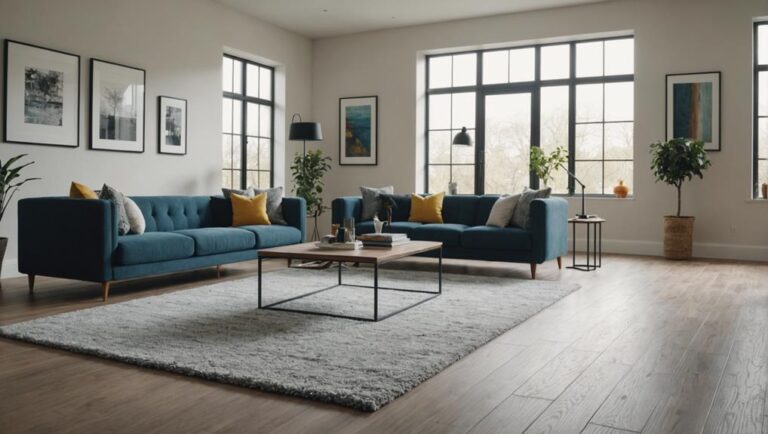At Chic Refuge, our expertise in interior design and styling enables us to provide insights on hardwoods that expertly withstand heavy foot traffic.
The top choices for durability include hickory, oak (especially red and white), and hard maple. These hardwood species excel on the Janka scale, showcasing exceptional resistance to scratches and dents.
Hickory is particularly notable for its impressive density, while oak strikes a perfect balance between strength and visual appeal.
To further enhance the longevity of your flooring, consider incorporating maintenance practices such as protective coatings and area rugs.
Selecting the right hardwood not only elevates your space aesthetically but also ensures lasting performance, guiding you towards a stylish and resilient home environment.
Key Takeaways
- Hickory is one of the most durable hardwoods, excelling in resisting dents and scratches, making it ideal for high-traffic areas.
- Red Oak combines natural hardness and warmth, making it a popular choice for busy homes despite being slightly softer than other options.
- Maple offers excellent durability and a smooth finish, particularly the hard maple variety, suitable for heavy foot traffic environments.
- White Oak features a tighter grain and moisture resistance, making it versatile for both indoor and outdoor high-traffic settings.
- Engineered hardwood provides enhanced stability and moisture resistance, making it a great option for active spaces with heavy foot traffic.
Best Hardwoods for Durability

When it comes to choosing hardwoods that can handle heavy foot traffic, durability is key. We should focus on materials known for their hardwood resilience, ensuring they can withstand everyday wear and tear without sacrificing beauty.
One standout option is oak, particularly red oak, which boasts impressive traffic resistance. Its natural hardness makes it a popular choice for busy homes.
Another excellent hardwood is hickory. Known for its density and strength, hickory has a unique ability to resist dents and scratches, providing an enduring surface that can handle even the most active environments.
Maple is also a contender, offering a smooth finish and remarkable durability that holds up well under heavy usage.
Lastly, we can’t overlook cherry wood. While slightly softer than other choices, its exquisite grain and rich color will still provide a lasting beauty when properly cared for.
When selecting the best hardwoods for durability, we need to take into account not only the material’s resilience but also how it fits our lifestyle.
With the right choice, we can enjoy the elegance of hardwood floors without compromising on their ability to endure life’s daily activity.
Characteristics of High-Traffic Floors

Choosing the right hardwoods is just the beginning; understanding the characteristics that make high-traffic floors successful is equally important. One of the standout features we should focus on is wear resistance. Floors in high-traffic areas frequently endure scuffs, scratches, and dents. Selecting a hardwood with superior wear resistance guarantees that our floors maintain their beauty and functionality despite heavy use.
Another essential aspect is the choice of flooring patterns. Incorporating certain patterns can’t only enhance aesthetic appeal but also improve the durability of the flooring. For example, wider planks or herringbone designs can help minimize the visibility of scratches and dents, giving our floors a longer-lasting pristine look.
Additionally, we should consider the grain pattern of the wood; tighter grain patterns often provide greater resilience. Engineered hardwood can also be beneficial, as it typically offers enhanced stability and resistance to moisture.
Lastly, regular maintenance, including cleaning and refinishing, will go a long way in prolonging the life of our high-traffic floors. By understanding these characteristics, we can ascertain that we choose the right hardwoods for our bustling homes.
Top Wood Species Compared

Selecting the right wood species is essential for creating durable floors that can handle heavy foot traffic. When we look at top hardwood contenders, maple varieties stand out for their exceptional resilience. Among them, hard maple is particularly significant for its fine grain and resistance to wear, making it an excellent choice for busy areas like hallways and entryways.
On the other hand, oak comparisons reveal that both red and white oak offer impressive durability and style. White oak tends to have a tighter grain and greater resistance to moisture, which makes it suitable for both indoor and outdoor settings. Red oak, while slightly softer, still withstands everyday wear and tear exceptionally well, and its warm tones add character to a space.
When considering maple and oak, we should also factor in aesthetics and maintenance. While both options can endure heavy foot traffic, the choice often boils down to personal preference and desired appearance.
Ultimately, we recommend visiting local suppliers to see samples in person, allowing us to make an informed decision that meets our specific needs and style preferences.
Comparing Hardness Ratings

Frequently, we find ourselves considering hardness ratings when evaluating hardwoods for high-traffic areas.
Understanding the hardness ranking not only informs us of the wood’s durability but also its wear resistance. Selecting the right wood can greatly impact the longevity of our flooring.
Let’s explore three key points regarding hardness ratings:
- Janka Scale: The standard for measuring the hardness of wood, helping us compare species effectively.
- Wear Resistance: An essential factor that indicates how well a wood species will hold up against scratches and dents.
- Versatile Choices: Species like oak, hickory, and maple score higher on the Janka scale, making them ideal for tough environments.
Maintenance Tips for Longevity

Over time, proper maintenance can greatly extend the life of our hardwood floors, especially in high-traffic areas.
To achieve this longevity, we should implement effective cleaning techniques regularly. Dust and dirt can cause scratches, so a weekly vacuum with a soft-bristle attachment is crucial. We can also use a damp mop with a pH-neutral cleaner specifically designed for hardwood. This combination helps shield our floors while keeping them pristine.
In addition to cleaning, utilizing protective coatings is necessary. Periodically applying a high-quality finish can create a barrier against damage from foot traffic, scratches, and spills. We should consult with professionals about the best options for our specific hardwoods, ensuring compatibility and peak performance.
Also, placing area rugs in high-traffic zones can greatly reduce wear and tear.
These small adjustments can have a considerable impact on the durability of our floors.
Finishes That Protect Flooring

Choosing the right finish can profoundly influence the longevity and appearance of our hardwood floors. A well-chosen finish provides a protective barrier against the wear and tear of heavy foot traffic while enhancing the wood’s natural beauty.
Let’s explore three vital elements to reflect on when selecting finishes:
- Types of Protective Coatings: Polyurethane is one of the most popular finishes due to its durability and resistance to scratches. We can choose between oil-based or water-based options, depending on our specific needs.
- Sheen Levels: Finishes come in various sheen levels, from matte to high gloss. We should contemplate our lifestyle and aesthetic preferences here. A matte finish might hide scratches better but a glossy finish can enhance visuals.
- Application Method: Some finishes require professional application, while others can be DIY projects. It’s essential to follow manufacturer instructions for best results.
Installation Considerations

While we might envision the beauty of hardwood flooring, installing it properly is just as vital to its long-term performance, especially in areas with heavy foot traffic. To guarantee durability, we must first pay attention to subfloor requirements. A solid, flat, and dry subfloor is essential, as any imperfections can lead to issues down the line.
If our subfloor is concrete, we should eliminate moisture risks by using a vapor barrier.
Next, we should focus on the installation techniques we choose. Whether we opt for nail-down, glue-down, or floating methods, knowing the best approach can greatly influence the flooring’s stability. For high-traffic areas, nail-down installations are often preferred because they secure the planks firmly.
We can also consider acclimating the wood to the environment for at least 72 hours—a step that helps minimize expansion or contraction after installation.
Benefits of Area Rugs

Area rugs can be a smart addition to hardwood floors, especially in high-traffic areas. They not only enhance the aesthetic appeal of a space but also offer significant benefits that we shouldn’t overlook.
Let’s explore some key area rug advantages together:
- Traffic Protection: By placing area rugs in high-traffic zones, we reduce wear and tear on our hardwood floors. This layer acts as a buffer, protecting the surface from scratches and dents.
- Safety Benefits: Area rugs can help prevent slips and falls. A well-placed rug provides traction, especially in areas that might be prone to moisture, keeping our family and guests safe.
- Noise Reduction: An area rug absorbs sound, which is particularly beneficial in busy homes. It minimizes echoes and creates a more serene environment, balancing out the often echoey nature of hardwood.
Incorporating area rugs into our homes not only enhances visual warmth but also fortifies our hardwood flooring against daily wear.
Cost Vs. Durability Analysis

When we look at the balance between cost and durability in hardwoods, it’s vital to reflect on how our investment aligns with daily use. A thorough cost analysis reveals that while some hardwoods may seem more affordable upfront, their long-term durability factors can dramatically affect overall costs. For instance, oak and maple are typically priced higher but last much longer under heavy foot traffic than softer woods like pine.
Investing in a more expensive hardwood can save us money in the long run. We need to evaluate the frequency of our family gatherings, pets, or simply the hustle and bustle of daily life. The best choices resist scratches, dents, and other wear, which ultimately means less maintenance and fewer replacements.
Additionally, examining the maintenance costs is essential. Some finishes may require frequent refinishing, while others might hold up for decades. By weighing these factors, we can make a more informed choice.
Balancing quality and cost isn’t merely about the initial outlay; it’s about projecting future expenses and ensuring that our investment in hardwood flooring pays dividends in durability and aesthetic appeal over time.
Eco-Friendly Hardwood Options

Eco-consciousness has become increasingly important in our choices, and hardwood flooring is no exception. When we decide on flooring, we can embrace options that not only look beautiful but also tread lightly on the planet.
Here are three eco-friendly hardwood choices that stand up to heavy foot traffic:
- Bamboo: Technically a grass, bamboo grows quickly and can be sustainably sourced in just a few years, making it a renewable choice.
- Reclaimed Wood: This flooring option repurposes old wood from structures, minimizing waste and preserving existing resources while adding character to our interiors.
- FSC-Certified Hardwoods: Selecting hardwoods with Forest Stewardship Council (FSC) certification guarantees the wood comes from well-managed forests, prioritizing sustainable sourcing and ecological balance.
When choosing eco-friendly hardwoods, look for reputable flooring certifications, which help us identify products that meet rigorous environmental and social standards.
With these options, we can create stylish, durable spaces that feel good—both aesthetically and ethically. Embracing eco-friendly hardwood not only enhances our homes but also contributes positively to our planet’s future!
Frequently Asked Questions
Can Engineered Hardwoods Handle Heavy Foot Traffic Effectively?
We recognize that engineered hardwoods can effectively handle heavy foot traffic when properly installed. By following maintenance tips and using effective installation techniques, we can guarantee they last beautifully in our busy spaces.
How Does Humidity Affect Hardwood Durability Over Time?
Humidity plays a critical role in hardwood durability. We should prioritize humidity control and install moisture barriers to protect our floors from warping and extending their lifespan, ensuring they remain beautiful and functional for years.
Are Certain Colors or Finishes More Resistant to Wear?
When we chose a deep mahogany finish for our floor, we noticed it hid scratches better than lighter colors. We’ve found that darker shades often camouflage wear, while certain finishes enhance durability against scuffs and scratches.
What Types of Footwear Damage Hardwood Floors the Most?
We’ve noticed that high-heeled shoes have a significant heel impact on hardwood floors, causing dents and scratches. Additionally, footwear with hard, abrasive sole materials can also contribute to damaging the finish over time.
How Do Different Subfloors Impact Hardwood Performance in High Traffic Areas?
It is understood subfloor types greatly influence hardwood performance. Proper load distribution helps prevent damage in high traffic areas. Choosing the right subfloor guarantees durability and maintains our beautiful hardwood floors for years to come.





